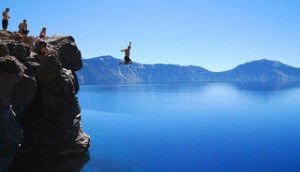I continue to think about the definition and use of this word safety, which we facilitators are charged with creating and maintaining. (See previous post here.)
A family camping trip this past weekend gave me opportunities to consider the issue in a different context. We camped in the woods near a large lake; swimming, fishing and kayaking were major activities throughout the trip. We had the obligatory marshmallow-roasting campfire each night.
We ranged in age from nineteen to fifty-five. The twenty-something who had had never kayaked stayed close to others. The nineteen-year-old paddled farther from the rest of the group, jumped off of higher rocks, and built bigger fires than the older family members found comfortable. There were numerous exchanges of “That isn’t safe!” “Sure it is!”
We refer to something as safe if there is a low risk of danger or injury. But how low is low enough? How much risk is acceptable? There is no absolute definition. Our emotional feeling of safety may be completely disconnected from the actual statistical likelihood of injury from a given activity. Even if we do have data on past events – how many people in the past year were injured or died performing the activity in question – there is still a personal risk/benefit ratio. If I perceive a 95% likelihood of having major fun diving off this rock versus a 5% chance of hitting my head on the bottom, I’m likely to go for it.
Things get even stickier when we start talking about emotional safety within a group context. Everyone comes to the table with different histories and varying levels of tolerance for discomfort. Add different communication styles, cultural backgrounds, and introversion/extroversion and you have many opportunities for misunderstanding. I may say something to you in a tone of voice that seems perfectly neutral, reasonable, and non-threatening to me but that you receive as an attack.
Just as we can’t guarantee total safety out in the wilderness, we can’t guarantee total safety in the conference or workshop room. What we can do is learn about the most common dangers and carry the tools needed to prevent or mitigate them. It’s often wise to go into the wilderness with a guide who knows the territory, whether that wilderness is outside or inside!
